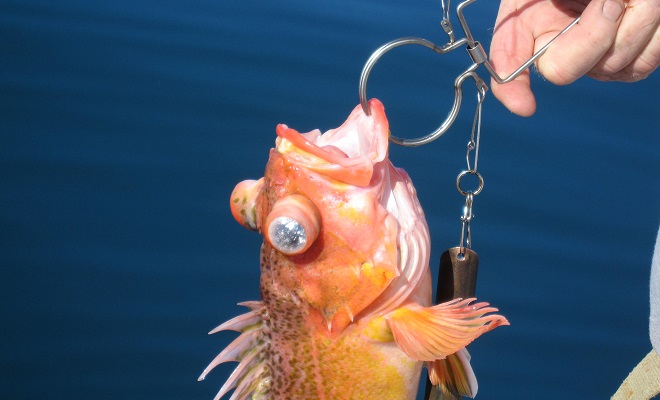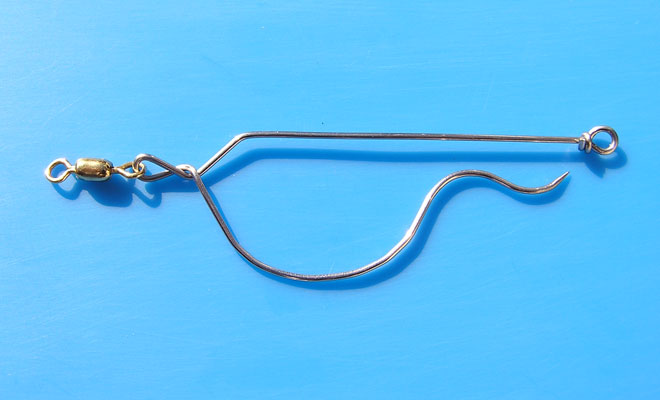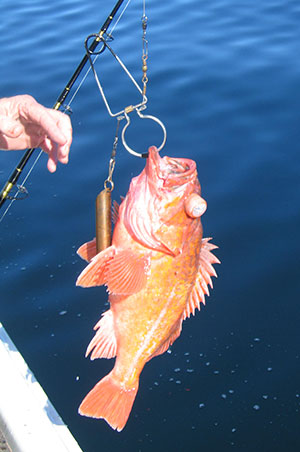
Any rockfish brought up from depths of 60 feet or more will suffer barotrauma. © EcoLeeser
Going Down – Descenders for Rockfish
Rockfish Descenders blog by George Krumm
Rockfish descenders (aka descending devices) are becoming required for some groups of fishermen and anyone fishing for bottomfish in parts of Alaska in 2019.
Rockfish descenders are becoming required for everyone, everywhere, because descenders are undoubtedly the best tool we have in the box to prevent the decimation of nonpelagic (aka demersal) rockfish populations, short of not fishing near or on the bottom.
What are fish descenders?
Any rockfish brought up from depths of 60 feet or more will suffer barotrauma. Symptoms include bulging eyes (exophthalmia), an inverted esophagus (stomach protruding from the mouth), ocular emphysema (air bubble under the cornea; sometimes it looks as though the cornea has crystallized), sluggishness, and an inability to submerge and swim back to the bottom. Without a fish descender, such a fish is a sure goner, doomed to become eagle food, sea lion food, etc. But with a descender, you can quickly lower the fish back down to the depths, and the symptoms of barotrauma are reversed. The fish almost always recovers, and the population isn’t diminished.

The SFD™ or Shelton Fish Descender © Bill Shelton
Nonpelagic rockfish populations in Washington and Oregon have been hammered to the point of widespread closures. Because it takes up to 20 years for some species of nonpelagic rockfish (yelloweye, for example) to reach maturity, if you harvest or kill one, it will take at least 20 years to replace that fish. Yelloweye rockfish can live to over 100 years of age, so if you kill a big one, it will take that long to replace it. Harvesting such fish regularly, from the same areas, is simply unsustainable. We anglers—charter, sport, and commercial—must limit our catch of nonpelagic rockfish or we’ll end up with the same widespread closures seen in Washington and Oregon today.
It is important, as sport anglers, to be able to identify the common nonpelagic rockfish. In Alaska, yelloweye, copper, quillback, china, tiger, and silvergray rockfish are some of the ones anglers are most likely to encounter. These are the rockfish to consider releasing.
Pelagic rockfish are much more numerous, and mature much sooner than nonpelagic rockfish. Pelagics are the ones to take home for the table, and common pelagics in Alaska include black, dusky, yellowtail, widow, and dark rockfish. In Alaska, for the purpose of regulations, any rockfish besides these five species will be considered nonpelagic.
Therefore, we recommend you consider not harvesting nonpelagic species. With a descender on board, you can fish for and harvest lingcod, halibut and pelagic rockfish, and be able to release any nonpelagics back to the safety of the depths where they can recover. It is our experience that pelagic rockfish and nonpelagic rockfish taste about the same, so there is no reason to kill a nonpelagic when pelagics are more plentiful, can handle more harvest, and are just as tasty. Also, with a descender at the ready, it is possible to take a quick picture of a big yelloweye before you descend it back down to the depths.
Note: We at Fish Alaska do not endorse the intentional catch-and-release of nonpelagics strictly for photos—a practice that is unethical, in our opinion.
There are a few different descenders on the market today. The Shelton Fish Descender, the EcoLeeser RockLees, and the SeaQualizer are three that we’re familiar with. They all work well. You should pick one and know how to use it. Alternatively, you can make a homemade fish descender. Here’s a video example from ADF&G showing several homemade descenders. There is also a great ADF&G video regarding descending a big yelloweye. Here’s a video showing ADF&G descending a silvergray rockfish using a Seaqualizer. That video shows the eyes returning to normal and the stomach receding back inside the fish’s abdomen as the fish descends.

Fish descenders need to be readily available and ready to use. © EcoLeeser
How do fish descenders work?
In order to be effective, fish descenders need to be readily available and ready to use, as in as soon as the fish to be released reaches the surface. Similarly, anglers need to know how to use their descender of choice ahead of time, so that the fish can be sent back to the depths as soon as possible. Our suggestion is to study your descender and the instructions that come with it before you go fishing. Also, we suggest you have a dedicated rod/reel just for sending rockfish back down to the depths. This rod should only be used for descending rockfish, and it would be advantageous for it to be short and maneuverable. A rod similar in length and action to half a pool cue would work well. It needs to be able to support a couple or few pounds of weight—a big yelloweye will likely require a couple or few pounds of weight to take it down expeditiously. The descender rod doesn’t need to bend—we’re not fighting fish—we’re descending them. A reel that can hold several hundred feet of 40-pound braid would work fine, as long as the reel is capable of retrieving the 2- or 3 pounds of weight you use. This short rod/reel combo can easily be stored, and it’s very maneuverable making it easy to use.
ADF&G regulations regarding descending rockfish use this language: “All nonpelagic rockfish must be released at depth of capture or at least 100 feet.” No doubt, most of the barotrauma symptoms are alleviated by the time the fish gets descended back down to 100 feet deep. Even if the fish is caught in 250 feet of water, once descended to 100 feet deep, with the major symptoms gone, the fish will be able to swim back down to the bottom and recover completely. If you feel like descending the fish all the way to the bottom, feel free to do so. In water shallower than 100 feet, you are required to descend the fish all the way to the bottom.
Why use a fish descender for rockfish?
When I was a little kid growing up in Tacoma, Washington, we used to catch several species of nonpelagic rockfish in Puget Sound: yelloweye rockfish, china rockfish, copper rockfish, quillback rockfish, and others. By the time I graduated from high school in the early 80s, yelloweye were largely absent in Puget Sound due to one thing—overharvest.
In Alaska, we are heading down that same road. Thankfully, ADF&G has learned something from what happened down south. Hopefully, private anglers, charter operators, and commercial fishers will too, before it’s too late. We have the chance to learn from the mistakes made down south, and with the use of descenders and some old-fashioned Alaskan self-discipline, we can ensure that our children’s grandkids get to marvel at the sight of a bright orange, 15-pound yelloweye…just before they descend it back down to the depths.
George Krumm is Editor of Fish Alaska and Hunt Alaska magazines. He can be reached via email at George@FishAlaskaMagazine.com.
